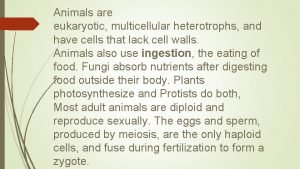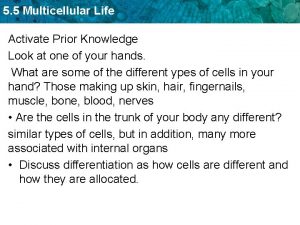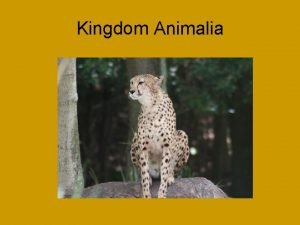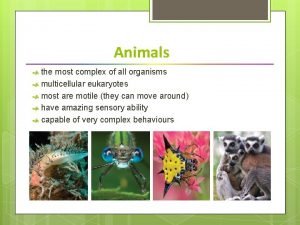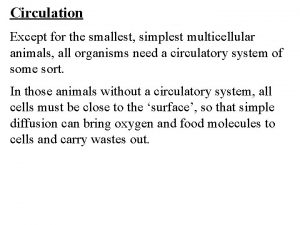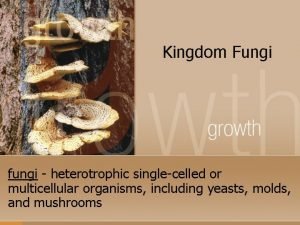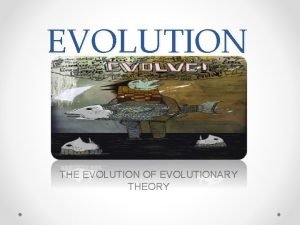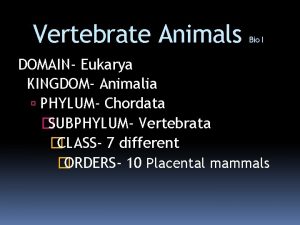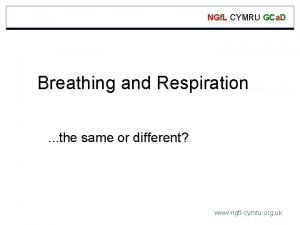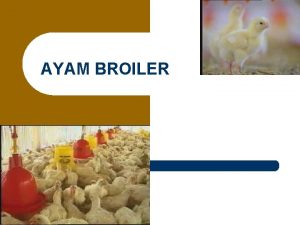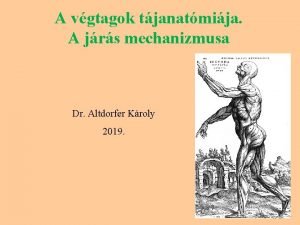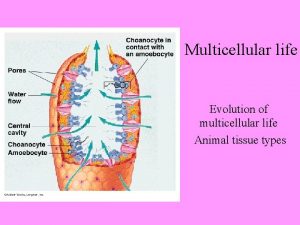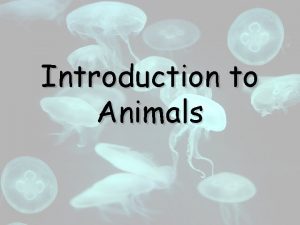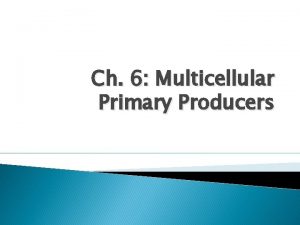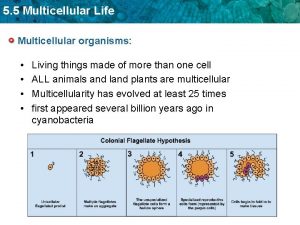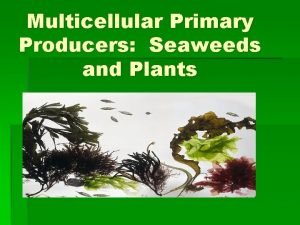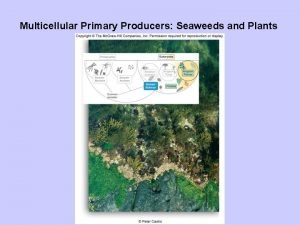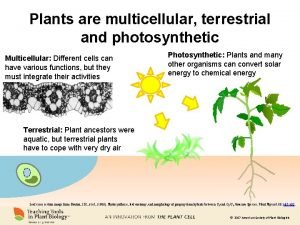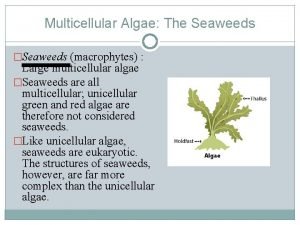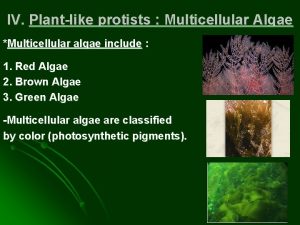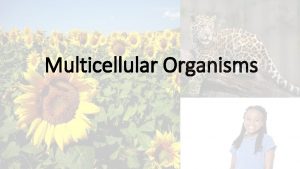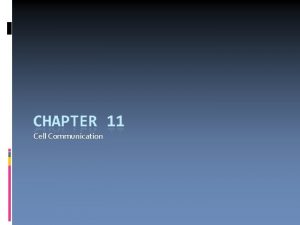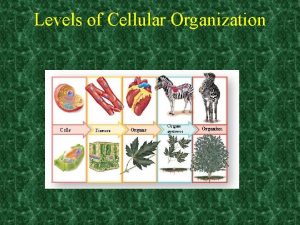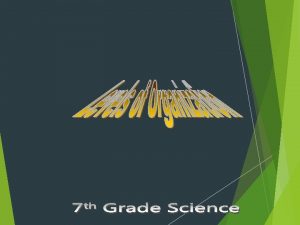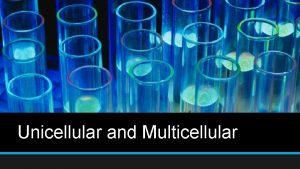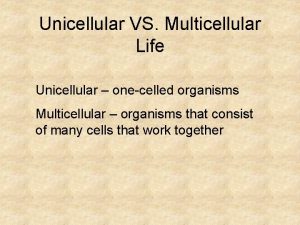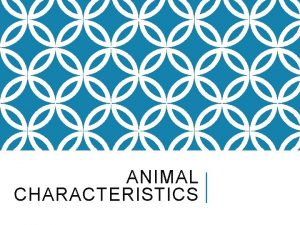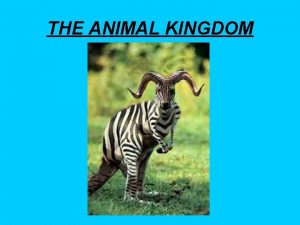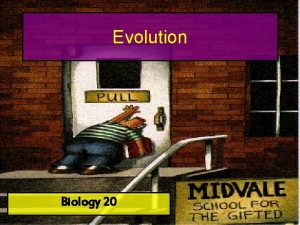Evolution of Animals l All animals are multicellular

































- Slides: 33

Evolution of Animals l All animals are multicellular heterotrophic organisms that must take in preformed food Fungi digest their food externally and absorb the breakdown products. l Animals ingest (eat) whole food and digest it internally. l l Animals have the diploid life cycle l Animals are monophyletic l Both invertebrates and vertebrates can trace their ancestry to the same ancestor 1

Evolution of Animals l Classification l Level of organization l l Criteria Cellular, tissue, organ Body Plan l Sac plan - have an incomplete digestive system l l Only one opening used for both entrance and exit. Tube-within-a-tube plan - have a complete digestive system l Separate entrance and exit to the digestive system 2

Evolution of Animals l Classification l Criteria, (cont. ) Symmetry Asymmetry means there is no particular body shape (e. g. , sponge). l Radial - Two identical halves (e. g. , starfish) l l l Enables an animal to reach out in all directions Bilateral - Definite right and left halves l l Animals tend to be active and to move forward at an anterior end The development of a head to localize the brain and sensory organs at the anterior end is called cephalization 3

Evolution of Animals l Classification l Criteria, (cont. ) Segmentation is repetition of body parts along the length of the body Mollusks and echinoderms are non-segmented. l Annelids, arthropods, and chordates are segmented. l l Segmentation leads to specialization 4

Evolution of Animals l Type of Coelom Pseudocoelom l Coelom l l Early Developmental Pattern Protostome - First embryonic opening becomes the mouth l Dueterostome - Second embryonic opening becomes the mouth l 5

Phylogenetic Tree of Animals deuterostome development Chordates bilateral symmetry 3 tissue layers body cavity Echinoderms tissue layers Arthropods Roundworms Bilateria molting of cuticle Ecdysozoa common ancestor Deuterostomia Copyright © The Mc. Graw-Hill Companies, Inc. Permission required for reproduction or display. Molluscs choanoflagellate ancestor Flatworms protostome development Lophotrochozoa trochophore multicellularity Protostomia Annelids Rotifers Lophophores lochophore Radiata Comb jellies radial symmetry 2 tissue layers Cnidarians Sponges 6

Multicellularity l Sponges Only level of animal to have cellular organization l Saclike bodies perforated by many pores l Beating of flagella produces water currents that flow through pores into central cavity and out osculum l Sessile filter feeders l Asexual reproduction by fragmentation or budding l 7

True Tissue Layers l Total of three possible germ layers Ectoderm l Endoderm, and l Mesoderm l l phlya Ctenophora and Cnidaria develop only ectoderm and endoderm Diploblasts l Radially symmetrical l 8

Comb Jellies l Small, transparent, and often luminescent l Most of body composed of mesoglea l Largest animals propelled by beating of cilia l Capture prey with tentacles 9

Cnidarians l Tubular animals that most often reside in shallow marine waters l Polyp and medusa body forms l Specialized stinging cells (cnidocytes) l l l Fluid-filled capsule, nematocyst Two-layered body sac l Outer layer - Protective epidermis l Inner layer - Gastrovascular cavity Nerve net found throughout body 10

Cnidarian Diversity Copyright © The Mc. Graw-Hill Companies, Inc. Permission required for reproduction or display. a. Sea anemone, Corynactis b. Cup coral, Tubastrea c. Portuguese man-of-war, Physalia d. Jellyfish, Crambionella a: © Azure Computer & Photo Services/Animals/Earth Scenes; b: © Ron Taylor/Bruce Coleman; c: © Runk/Schoenberger/Grant Heilman Photography; d: © Under Watercolours 11

Bilateral Symmetry l Ribbon worms (phylum Nemertea) l l Have distinctive proboscis Flatworms (phylum Platyhelminthes) l Majority are parasitic l Organ-level organization l No specialized circulatory or respiratory structures l Have undergone cephalization l Ladder-type nervous system 12

Planarians l Planarians, (cont. ) Excretory organ functions in osmotic regulation and water excretion l Can reproduce asexually l Hermaphroditic l l Practice cross-fertilization 13

Life Cycle of Schistosomiasis Copyright © The Mc. Graw-Hill Companies, Inc. Permission required for reproduction or display. 2. Adult worms live and copulate in blood vessels of human gut. 1. Larvae penetrate skin of a human, the primary host, and mature in the liver. 6. Larvae (cercariae) break out of daughter sporocysts, escape snail, and enter water. a. b. 3. Eggs migrate into digestive tract and are passed in feces. 5. In the snail, a mother sporocyst encloses many developing daughter sporocysts; daughter sporocysts enclose many developing larvae (cercariae). 4. Ciliated larvae (miracidia) hatch in water and enter a snail, the secondary host. © SPL/Photo Researchers, Inc. 14

Life Cycle of a Tapeworm, Taenia Copyright © The Mc. Graw-Hill Companies, Inc. Permission required for reproduction or display. hooks proglottid 2. Bladder worm attaches to human intestine where it matures into a tapeworm. 1. Primary host ingests meat containing bladder worms. 6. Rare or uncooked meat from secondary host contains many bladder worms. scolex 1. 0 mm sucker 250 mm 3. As the tapeworm grows, proglottids mature, and eventually fill with eggs. 5. Livestock may ingest the eggs, becoming a secondary host as each larva becomes a bladder worm encysted in muscle. 4. Eggs leave the primary host in feces, which may contaminate water or vegetation. 15

Mollusks l (phylum Mollusca) Have three-part body plan l Visceral Mass l l Mantle l l Contains internal organs May secrete shell and/or contribute to development of gills or lungs Foot l Muscle adapted for locomotion, attachment, or food capture 16

Mollusks l Mollusks (cont. ) Nervous system consists of several ganglia connected by nerve cords l Coelom is reduced, and largely limited to the region around the heart l Heart pumps hemolymph through vessels into hemocoel l 17

Bivalves Clams, oysters, mussels, and scallops l Shell of two hinged parts, closed by powerful muscles l No head, no radula l Circulatory system open l Sexes are separate l Ciliated gills hang down within mantle cavity on either side of visceral mass l l l Beating of cilia causes water to enter cavity Filter Feeders – capture tiny food particles suspended in water 18

Cephalopods l Head Footed l Force water out mantle cavity l Tentacles and arms capture prey by adhesive secretions or suckers l Beak used to tear prey apart l Well-developed sense organs l Closed circulatory system l Spermatophore packets passed from males to females 19

Gastropods l Have elongated, flattened foot l Well-developed head region l Eyes and tentacles project from coiled shell l Gills are found in mantle cavity in aquatic gastropods l Mantle functions as lung in terrestrial gastropods 20

Gastropod and Cephalopod Diversity Copyright © The Mc. Graw-Hill Companies, Inc. Permission required for reproduction or display. tentacle spotted mantle covers shell siphon gills foot eyes mantle eye a. Flamingo tongue shell, Cyphoma gibbosum foot b. Nudibranch, Glossodoris macfarlandi eye growth line spiral shell foot c. Land snail, Helix aspersa fins shell arm tentacles arms and tentacles with suckers eye suckers d. Two-spotted octopus, Octopus bimaculatus e. Chambered nautilus, Nautilus belauensis f. Bigfin reef squid, Sepioteuthis lessoniana a: © M. Gibbs/OSF/Animals/Earth Scenes; b: © Kenneth W. Fink/Bruce Coleman, Inc. ; c: © Farley Bridges; d: © Ken Lucas/Visuals Unlimited; e: © Douglas Faulkner/Photo Researchers, Inc. ; f: © Georgette Douwma/Photo Researchers, Inc. 21

Annelids l Phylum Annelida are l Segmented partitions (septa) divide the welldeveloped, fluid-filled coelom, which acts as hydrostatic skeleton l Specialized digestive tract l Closed circulatory system l Ventral solid nerve cord l Most are marine l Setae (bristles) help in movement 22

Earthworms l Segmentaion evidenced by: Body rings l Coelom divided by septa l Setae on most segments l Gangli and lateral nerves in each segment l Nephridia in most segments l Branch blood vessels in each segment l 23

Leeches l Usually found in fresh water l Same body plan as other annelids No setae l Two additional suckers l Some parasitic l Keep blood flowing and prevent clotting by means of hirudin, a powerful anticoagulant l 24

Pseudocoelom l Pseudocoelom: A “false” body cavity that is incompletely lined by mesoderm l Provides a space for internal organs and can serve as hydrostatic skeleton l l Roundworms (phylum Nematoda) Non-segmented, generally colorless worms l Several parasitic roundworms infect humans l 25

Parasitic Roundworms l Ascaris – Intestinal roundworm l Trachinella - Trichinosis l Dirofilaria - Heartworms l Wuchereria - Elephantiasis 26

Roundworm Diversity Copyright © The Mc. Graw-Hill Companies, Inc. Permission required for reproduction or display. cyst a. b. SEM 400× c. a: © Lauritz Jensen/Visuals Unlimited; b: © James Solliday/Biological Photo Service; c: © Vanessa Vick/The New York Times/ Redux 27

Arthropods l Arthropods (phylum Arthropoda) have freely movable jointed appendages l Very successful due to many characteristics l Rigid, jointed exoskeleton l l Segmented, but some segments are fused into regions l l Must molt as they grow Head, thorax, abdomen Well-developed nervous system 28

Crustaceans l Decapods are the most familiar and numerous of crustaceans l Shrimp, lobsters, crayfish, and crabs Thorax bears five pairs of walking legs l Head and thorax fused into cephalothorax l Covered by nonsegmented carapace l Abdominal segments equipped with swimmerets l l Respiratory system consists of gills 29

Uniramians l Include insects, millipedes, and centipedes l Appendages attached to the thorax and abdomen only have one branch l Head appendages include: l l Only one pair of antennae l One pair of mandibles, and l One or two pairs of maxillae Live on land breathe by tracheae 30

Chelicerates l Include terrestrial spiders, scorpions, ticks, mites, horseshoe crabs and sea spiders l All appendages attached to cephalothorax; none on head First pair (chelicerae) are feeding organs l Second pair (pedipalps) function in feeding or sensory l 31

Echinoderms l Sea stars, sea urchins, sea cucumbers, and sea lilies l Radial symmetry as adults (not as larvae) l Internal calcium-rich plates with spines l Central nerve ring with branches l Water vascular system for locomotion 32

Echinoderms Copyright © The Mc. Graw-Hill Companies, Inc. Permission required for reproduction or display. aboral side arm cardiac stomach pyloric stomach anus arm sieve plate (madreporite) spine central disk endoskeletal plates aboral side eyespot skin gill gonads tube feet coelomic cavity digestive gland tube feet bivalve mollusc ampulla radial canal a. b. Red sea star, Mediastar b: © Randy Morse, Golden. State. Images. com 33
 Antigentest åre
Antigentest åre All animals are multicellular heterotrophic eukaryotes
All animals are multicellular heterotrophic eukaryotes Section 17-3 evolution of multicellular life
Section 17-3 evolution of multicellular life Section 17-3 evolution of multicellular life answer key
Section 17-3 evolution of multicellular life answer key Multicellular characteristics
Multicellular characteristics Are animals multicellular
Are animals multicellular Unicellular organisms definition
Unicellular organisms definition Simplest multicellular animals
Simplest multicellular animals Name all the lines
Name all the lines Characteristics of kingdom plantae
Characteristics of kingdom plantae Is the kingdom fungi multicellular or unicellular
Is the kingdom fungi multicellular or unicellular Animal evolution chart
Animal evolution chart Change jcole
Change jcole Kyle douglass
Kyle douglass Animals that eat both plants and animals
Animals that eat both plants and animals G h patel college of engineering and technology
G h patel college of engineering and technology Animals that eat both plants and animals
Animals that eat both plants and animals Symbolize the statement “all cats are animals”.
Symbolize the statement “all cats are animals”. Domain eukarya kingdom animalia
Domain eukarya kingdom animalia All animals are equal
All animals are equal Once upon a time there lived a duck and a kangaroo
Once upon a time there lived a duck and a kangaroo All animals are equal
All animals are equal Gca
Gca Chapter 15 ocean water and ocean life
Chapter 15 ocean water and ocean life Love ever hurt never
Love ever hurt never Interventi sociali rivolti all'infanzia e all'adolescenza
Interventi sociali rivolti all'infanzia e all'adolescenza Crucified laid behind the stone
Crucified laid behind the stone I work all night
I work all night All-to-all personalized communication
All-to-all personalized communication Sistem all in all out
Sistem all in all out Itc semmelweis
Itc semmelweis Silent night holy night all is calm
Silent night holy night all is calm 馮定華神父
馮定華神父 All of you is more than enough for all of me
All of you is more than enough for all of me

